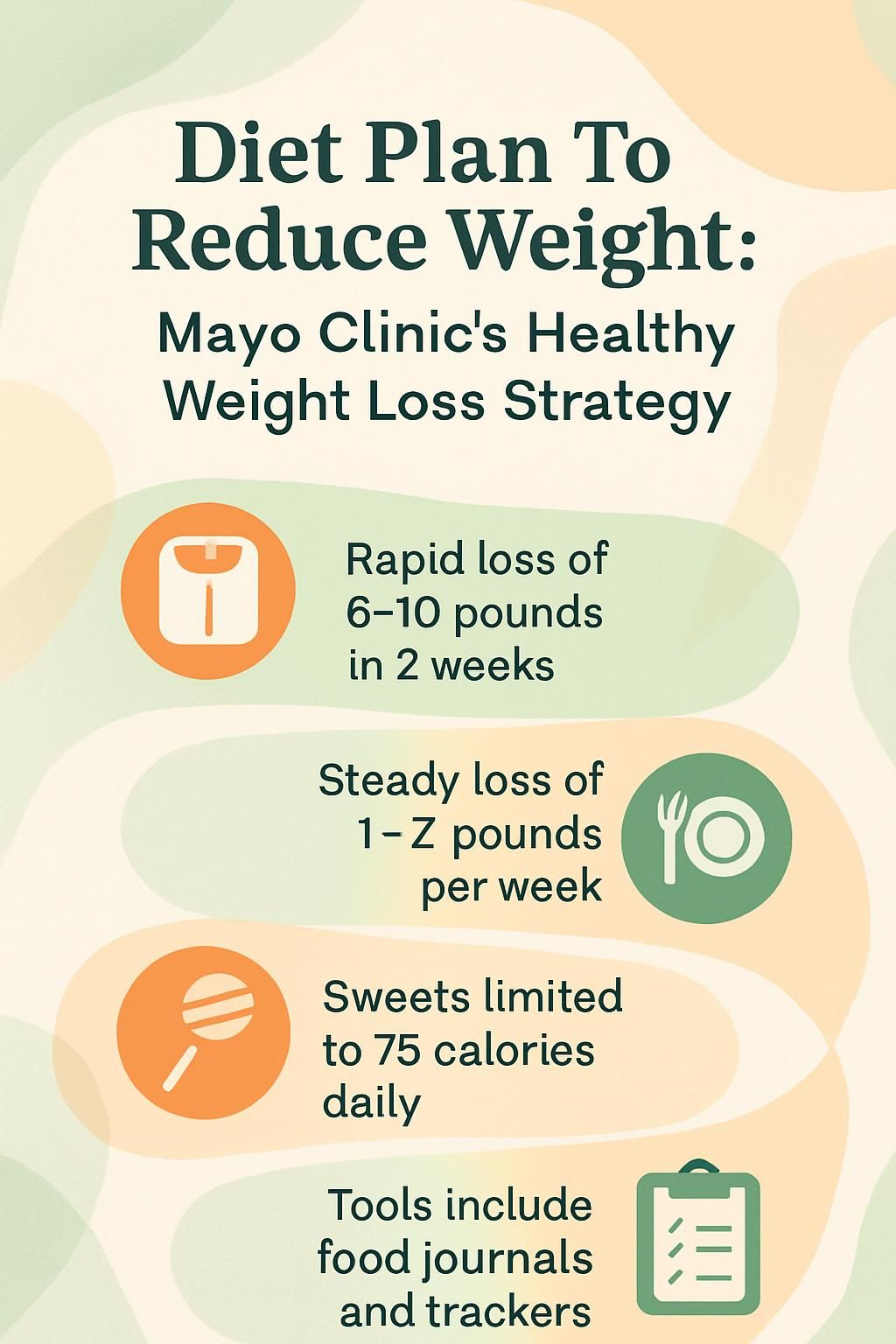Diet Plan To Reduce Weight: Mayo Clinic’s Healthy Weight Loss Strategy
Our Nutrition Assistant AI Suite will transform your body. You will lose fat, get toned, and build muscle. Gain confidence and optimal health.
If extra pounds have crept up and you want a clear diet plan, you are not alone. The Mayo Clinic Diet offers a simple, science-based way to support healthy weight loss without complicated rules. It teaches habits you can keep, which is key for long-term weight management and steady weight loss.
This guide shows you how the plan works, what to eat, and how to move more. You will learn easy actions that help you lose weight and keep it off. Small steps lead to big changes over time.
Keep reading to see how you can start building healthy eating habits today.
Key Takeaways
- The Mayo Clinic Diet begins with the two-week Lose It! phase that can lead to 6 to 10 pounds of rapid weight loss.
- After that, you aim for 1–2 pounds per week using portion control, unlimited fruits and vegetables, and regular physical activity.
- The Healthy Weight Pyramid centers on real foods like whole grains and lean proteins, with sweets limited to 75 calories a day.
- The plan replaces fad diets with lifelong habits, which can reduce risks for type 2 diabetes, high cholesterol, heart disease, and obesity.
- Tracking tools such as food journals and weight logs support progress; talk with a clinician first if you have chronic illness or take prescription medicine.

What is the Mayo Clinic Diet?

The Mayo Clinic Diet is a structured weight loss strategy built by medical experts. It emphasizes healthy eating, practical habits, and steady progress. You focus on real food and portion sizes instead of strict calorie counting.
What is the Mayo Clinic Diet?
This program comes from the Mayo Clinic, a leading academic medical center. You learn core habits rather than cutting entire food groups. The latest version, described in The Mayo Clinic Diet, 2nd edition (2017), includes several eating styles, such as vegetarian and Mediterranean plans, so you can choose what fits best.
You begin with the Lose It! phase, a two-week jumpstart that can help you shed 6 to 10 pounds using proven daily habits. Then you enter the Live It! phase for lifelong weight management. Most people lose about 1 to 2 pounds per week in this stage.
The Healthy Weight Pyramid guides portions and places fruits and vegetables at the base. You can eat these freely so you feel full while keeping calories lower. As Mayo Clinic Health System staff note, you do not need to eliminate any food group, which makes the plan easier to follow long term.
Why is the Mayo Clinic Diet sustainable for long-term weight loss?
The plan focuses on skills you can use for life, not quick fixes. The Live It! phase supports steady loss of 1 to 2 pounds per week until you reach your target. You get simple tools like a food journal and a weight tracker to keep momentum and stay accountable.
Unlimited vegetables and fruits help curb hunger with fewer calories. You can tailor meals to your taste and schedule. This flexibility lowers stress around meal planning and supports consistency.
These habits also help prevent weight regain and improve health markers linked to type 2 diabetes and heart disease. That is why many people consider it one of the best diets for maintaining results compared with low-calorie or restrictive approaches like the Atkins Diet.
How the Mayo Clinic Diet Works
This plan blends smart food choices with daily activity. Both parts matter. Together they support weight loss and help you maintain progress.
How does the Mayo Clinic Diet promote healthy eating habits?
You start the Lose It! phase by adding five healthy actions, dropping five unhelpful habits, and trying five bonus options. For example, reach for fruits and vegetables instead of high-calorie snacks. You do not weigh every bite. Instead, you follow balanced meal plans that include protein, whole grains, colorful produce, and healthy fats.
Journals and trackers help you spot patterns. Structured menus show what a balanced plate looks like. As the Mayo Clinic team explains, success comes from small daily changes that build up over time.
You will practice portion control while still enjoying foods from all groups, such as dairy, beans, nuts, eggs, lean meats, whole grain bread, or brown rice. Even an occasional treat fits, which makes the diet easier to maintain.
What is the Mayo Clinic Healthy Weight Pyramid?
The Healthy Weight Pyramid is the plan’s visual guide. Vegetables and fruits form the base, and you can enjoy them in generous amounts each day. These nutrient-dense foods supply vitamins, minerals, and dietary fiber, which help you feel full on fewer calories.
Whole grains, beans, nuts, fish, and healthy fats make up the next levels. They support heart health and lower your risk of obesity, high blood pressure, and cardiovascular disease. Sweets and heavily processed snacks sit at the top, so you eat them rarely.
This structure helps you plan meals and right-size portions as part of a low-calorie diet meal plan. On my first week using the pyramid, filling half my plate with produce made it easier to pass on extra snacks.
How can I increase my daily physical activity?
Food choices are central, but movement locks in results. Regular exercise helps you lose weight and keep it off. Start where you are and build up over time.
- Aim for at least 30 minutes of moderate activity most days to support weight loss and heart health.
- Try walking, cycling, bodyweight moves, or resistance training using bands or light weights.
- Move more during daily routines. Take stairs, stand during calls, or park farther away.
- Begin with short sessions if you are inactive, then add a few minutes every few days.
- Include strength work for muscle and stretching for flexibility to lower injury risk.
- Track your activity with a watch or journal to set goals and stay motivated.
- Check with a healthcare provider before new routines if you have conditions like hypertension or diabetes, if you use certain medicines, or if you are recovering from bariatric surgery.
- Choose fun options, such as dance or swimming, so you enjoy the process and stick with it longer.
- Use everyday tasks, like gardening or cleaning, to increase your total daily movement.
I started with 15-minute walks after dinner. Two weeks later, I felt more energetic and noticed a small drop on the scale.
Benefits of the Mayo Clinic Diet
The Mayo Clinic Diet supports healthy weight loss and helps you build new habits. Many people also see better blood pressure, improved blood sugar, and a lower risk of future disease.
How does the Mayo Clinic Diet support steady and sustainable weight loss?
The plan has two phases. During the first two weeks, called Lose It!, many people lose 6 to 10 pounds. After that, a pace of 1 to 2 pounds per week is typical until you reach your goal. Slow and steady loss helps you keep the weight off and lowers the risk of weight cycling.
You do not need complex apps. Instead, you focus on fruits, vegetables, whole grains, and lean proteins, while adjusting portions to your calorie needs, often between 1,200 and 1,800 calories a day. More activity replaces old routines, which supports long-term success without extreme restrictions.
How does the diet improve overall health and reduce risk factors?
Following this plan can lower your risk of type 2 diabetes, heart disease, high blood pressure, stroke, and sleep apnea. Fruits and vegetables add fiber and key nutrients that support gut health and may help with cancer prevention. Limiting added sugars and unhealthy fats improves cholesterol and blood pressure.
Structured meal planning steadies blood sugar, which supports metabolic health. Eating nuts, beans, fish, yogurt, and whole grains promotes heart health while you continue weight reduction. I began this pattern after my doctor flagged rising cholesterol. My energy improved, and my numbers moved in the right direction.
How does the diet encourage healthy lifestyle changes?
Lasting results come from daily habits. In the first two weeks, you replace five unhelpful habits and add five bonus habits. Meal planning centers on fruits, vegetables, and whole grains, not highly processed diet food. This cuts calories while protecting important nutrients.
Unlimited fruit and vegetables help you feel full with fewer calories. A simple food and exercise journal brings awareness to what you eat and how you move. The program adapts to different tastes, so you can enjoy meals that fit your life instead of following a very-low-calorie plan you cannot maintain.
You can also receive ongoing tips and recipes from Mayo Clinic experts. Using the weight tracker helped me see progress after a year. My energy climbed, cravings eased, and I stayed motivated without relying on meal replacement shakes or intermittent fasting plans like Weight Watchers.
Key Principles of the Mayo Clinic Diet
The Mayo Clinic Diet uses clear principles to shape everyday choices. These basics make the plan practical and effective for weight loss.
Why focus on fruits, vegetables, and whole grains?
Fruits, vegetables, and whole grains sit at the base of the Healthy Weight Pyramid. They are filling yet low in calories, which makes weight loss easier. High-fiber picks like pears, berries, beans, oats, and brown rice support digestion and help you stay satisfied.
Whole grains such as oatmeal and whole-wheat bread deliver steady energy and key nutrients. In a Mediterranean-style approach, you include vegetables and fruits at every meal along with nuts and beans. A 1,200-calorie day might start with overnight oats and fruit, a simple choice that supports heart and metabolic health.
How can I limit added sugars and unhealthy fats?
Choose whole foods such as vegetables, fruits, and whole grains instead of processed items. The pyramid places sweets and fried foods at the smallest tip, so keep them limited. Plan meals with healthy fats from nuts, seeds, and fish instead of foods high in saturated or trans fats.
Keep desserts to 75 calories per day, such as a small square of dark chocolate or a few spoonfuls of low-fat frozen yogurt. Watch for hidden sugars in condiments and drinks. Swapping soda for water or unsweetened tea can lower sugar fast and support better blood sugar control.
What is portion control and mindful eating?
Portion control means serving the right amount of food. The Mayo Clinic Diet teaches visual cues instead of strict counting. Build your plate around produce and whole grains, then add lean protein. In the Live It! phase, you learn menu planning so you can match servings to your energy needs.
Mindful eating means slowing down, eating without screens, and listening to hunger and fullness signals. A food journal improves awareness and highlights patterns. Many people who practice mindful eating find it easier to eat less and avoid grazing.
The Role of Physical Activity in the Diet
Think of movement as a daily investment. Consistent activity helps with calorie control and supports long-term results.
What are the daily exercise recommendations?
Aim for at least 30 minutes of movement each day while following the Mayo Clinic Diet. If you want greater weight loss or more health benefits, work up to about 60 minutes. Combine walking with resistance exercises to fit different fitness levels.
Start small if you are new to exercise, then add time as you build confidence and stamina. It is safer to spread your activity across the day than to do one big session at first. Talk with your healthcare provider before starting new routines if you have medical conditions or concerns. Regular exercise supports calorie control and lowers the risk of obesity-related problems like type 2 diabetes.
What types of physical activities should I consider?
Activity is a key pillar of the Mayo Clinic Diet. Mix options you enjoy so you stay consistent.
- Walk 30 to 60 minutes most days. It is effective, simple, and low impact.
- Do resistance training 2 to 3 times per week using bands or light weights to build muscle.
- Try swimming, cycling, or dancing to raise your heart rate and keep workouts fun.
- Take stairs, add walking breaks, and increase movement during work hours per day.
- Join group classes like yoga or Pilates for flexibility, balance, and strength.
- Use everyday activities, such as gardening or playing with a child, to add movement.
- Adapt your choices to your health status and ask your doctor if you have concerns as a Mayo Clinic patient.
- Pick activities you enjoy so you stay consistent and build strong habits over time.
Sample 7-Day Meal Plan for Weight Loss
A 7-day meal plan helps you practice the core habits. Use these ideas, then adjust for your preferences and calorie needs.
What should I eat for breakfast, lunch, and dinner on Day 1?
Day 1 offers balanced meals with protein, healthy fats, vegetables, and whole grains. These choices support energy and weight loss.
- Breakfast: Almond milk and Greek yogurt with mixed berries for protein, fiber, and antioxidants.
- Lunch: Large salad with leafy greens, grilled chicken, strawberries, cherry tomatoes, feta, and light honey Dijon dressing.
- Dinner: Salmon for omega-3 fats, with crispy onions and zucchini.
- Serve with quinoa or brown rice for complex carbs without excess calories.
- Drink water throughout the day to support hydration and appetite control.
- Use portion control at each meal to prevent overeating and support steady progress.
- This mix reflects a Mediterranean pattern that benefits health beyond weight loss.
What should I eat for breakfast, lunch, and dinner on Day 2?
Day 2 highlights fiber, lean protein, and fresh flavor. These foods support stable energy and healthy digestion.
- Breakfast: Whole grain toast topped with eggs, red pepper flakes, cilantro, and a squeeze of lime.
- Lunch: Hearty vegetable soup with greens and beans or tofu for protein and fiber.
- Dinner: Roasted boneless, skinless chicken breast with broccoli or carrots and a light honey-soy glaze.
- Drink water during and between meals to help manage hunger and support digestion.
- Aim for at least 25 grams of fiber across the day using vegetables, legumes, and whole grains.
- Adjust ingredients to fit your needs while limiting added sugars and unhealthy fats.
- Practice portion control with plates and visual cues to stay on track.
- Include a simple snack like carrot sticks or apple slices if you need it between meals.
What should I eat for breakfast, lunch, and dinner on Day 3?
Day 3 leans on plant proteins and colorful vegetables. The meals are filling and support long-term goals.
- Breakfast: Veggie scramble with spinach, broccoli, mushrooms, bell peppers, egg whites, and a little cheese.
- Lunch: Spicy extra-firm tofu with black beans and salsa for protein and fiber.
- Dinner: Bean and cashew burger seasoned with cumin, cayenne, and mustard. Cashews add healthy fats.
- Boost flavor with fresh herbs like cilantro or parsley instead of extra salt.
- Select ingredients that support steady weight management and match your taste.
- Limit added sugars to avoid energy crashes common with fad diets.
- Keep portions balanced at each meal to manage hunger and cravings.
- Drink water throughout the day to support focus and hydration.
- These meals gave me even energy during work, without feeling deprived.
- Adjust spices or swap vegetables to meet your dietary needs while staying aligned with the plan.
What should I eat for breakfast, lunch, and dinner on Day 4?
Day 4 uses Mediterranean-inspired meals that are simple and satisfying. Portion control keeps calories in check.
- Breakfast: Overnight oats with berries and a diced pear for fiber and vitamins.
- Lunch: Tuscan white bean soup with a drizzle of pesto for plant protein and healthy fats.
- Dinner: Sheet-pan roast chicken with broccolini, onions, and tomatoes for lean protein and antioxidants.
- Snack: One cup of sliced bell peppers and a banana for an easy energy boost.
- Dessert: Up to 75 calories, like low-fat frozen yogurt or a small piece of dark chocolate.
- These meals are filling and fit healthy calorie limits built into the plan.
- Including plant and animal proteins can help maintain muscle during weight loss.
- Brightly colored produce at each meal helps curb hunger and adds variety.
- Keep logging meals to support long-term success.
What should I eat for breakfast, lunch, and dinner on Day 5?
Day 5 features nutrient-dense options for balanced energy. The focus stays on vegetables, whole grains, and lean proteins.
- Breakfast: Oatmeal with sliced almonds and blueberries plus a side of low-fat milk for protein and fiber.
- Lunch: Grilled chicken with quinoa salad, cherry tomatoes, spinach, cucumbers, and a drizzle of olive oil. Including legumes or quinoa may support healthy weight loss.
- Dinner: Broiled salmon with roasted sweet potatoes and steamed broccoli for heart-friendly omega-3 fats.
- Snack: Carrot sticks or apple slices. Keep snacks portioned to meet your daily needs.
- Drink water throughout the day. Aim for about eight cups as part of healthy habits.
- Vegetarian swap: Use tofu or beans instead of chicken or fish to match your preferences.
- Limit processed foods and added sugars to support long-term weight management.
Each choice reflects the Mayo Clinic Diet principle of steady changes you can sustain.
What should I eat for breakfast, lunch, and dinner on Day 6?
Day 6 keeps meals simple using fresh produce, whole grains, and lean proteins. The goal is balance and convenience.
- Breakfast: One cup low-fat Greek yogurt with one sliced banana and one tablespoon chopped nuts for healthy fats.
- Mid-Morning Snack: Sliced cucumber and bell peppers to stay full on fewer calories.
- Lunch: Salad with mixed greens, cherry tomatoes, 3 ounces grilled chicken, olive oil, and balsamic vinegar.
- Afternoon Snack: An apple or orange plus 7 to 10 raw almonds for lasting energy.
- Dinner: Four ounces grilled or baked salmon with half a cup brown rice and steamed broccoli.
- Evening Snack (Optional): Skip if satisfied. If hungry, choose fresh berries.
- Drinks: Water is the main beverage. Avoid sugary drinks to support your results.
These practical meals fit busy days while supporting continued weight loss.
What should I eat for breakfast, lunch, and dinner on Day 7?
Day 7 wraps the week with familiar, flavorful choices. Keep snacks modest to stay within your calorie range.
- Breakfast: Oatmeal topped with fresh berries and chopped almonds for fiber and protein.
- Lunch: Grilled chicken breast, roasted sweet potatoes, and steamed broccoli fill half your plate with produce.
- Snack: Carrot sticks with hummus for a fiber-rich, plant-based bite.
- Dinner: Baked salmon, brown rice, and a mixed green salad with olive oil vinaigrette. Salmon provides omega-3 fats that support heart health.
- Dessert: Greek yogurt with sliced fruit for a light, sweet finish.
- Hydration: Aim for about eight cups of water across the day.
- I noticed higher energy on days built around whole grains, vegetables, and lean proteins.
This sample week shows how balanced meals can fit your calorie goals and still taste great.
Additional Tips for Success
Simple systems help you build consistency. These tactics make the plan easier to follow from week to week.
How can I track progress and set realistic goals?
Use the Mayo Clinic Diet journal to log meals, activity, and weight. Set a realistic goal of 1 to 2 pounds per week, which aligns with medical guidance. The plan’s weight tracker helps you adjust portions or activity as needed.
Check progress often to stay motivated. Mark small wins, such as five pounds lost or a full week of logging. When I hit early milestones, it felt easier to keep going and stick with the plan.
Why is staying hydrated and prioritizing sleep important?
Water supports digestion and helps manage appetite, especially with higher fiber intake. Aim for about eight cups daily. Drinking water before meals can help reduce overeating.
Sleep 7 to 9 hours per night. Good sleep lowers stress hormones that push cravings and makes weight control easier. Better rest also helps with focus and mood during the day.
What common dieting mistakes should I avoid?
Avoid these common pitfalls to improve your chances of steady results.
- Skipping meals or slashing calories can cause rebound gain and loss of muscle.
- Focusing only on calories instead of nutrient-dense foods reduces energy and immunity.
- Ignoring portion control makes long-term weight loss harder.
- Eating while distracted often adds extra calories without awareness.
- Relying on exercise alone without improving food choices limits results.
- Choosing rapid weight loss plans with weak evidence often leads to short-term outcomes and high risk.
- Eating too little protein can slow metabolism and reduce muscle during weight loss.
- Starting a restrictive plan without medical input can miss personal health needs.
- Picking fad diets that ignore nutrition quality can cause deficiencies and rebound weight gain.
Health Benefits Beyond Weight Loss
As you follow the plan, many health markers improve. People often notice clearer thinking and more energy too.
How does the diet reduce the risk of type 2 diabetes?
The plan favors vegetables, whole grains, and high-fiber foods. These slow the rise of blood sugar after meals. Limiting added sugars and refined carbs prevents big spikes. If you live with diabetes, a lower sugar lunch, like leafy greens with protein, can help control glucose.
Losing even 5 to 10 percent of body weight can improve blood sugar control and reduce medication needs. The Healthy Weight Pyramid also encourages daily activity, which improves insulin sensitivity.
^1 “The Mayo Clinic Diabetes Diet,” 2nd edition (2018)
How does it lower cholesterol and improve heart health?
Eating nuts, beans, fish, and healthy fats supports better cholesterol. Cutting unhealthy fats and added sugars lowers the risk of clogged arteries. Veggies and whole grains provide fiber that helps block cholesterol absorption.
The pyramid supports Mediterranean-style meals rich in plants and lean proteins. Portion control prevents overeating. After six months of consistent habits, my LDL cholesterol dropped, and my energy rose.
How does it enhance energy levels and mental clarity?
Balanced meals with whole grains, lean proteins, and healthy fats prevent energy highs and lows. Regular fruits and vegetables add vitamins that support brain function. The plan avoids extreme calorie cuts that can cause sluggishness and foggy thinking.
Staying hydrated and eating at regular times helps focus at school or work. Consistent sleep also supports memory and alertness.
Potential Risks and Considerations
Your health history matters. Adjust the plan or seek medical guidance if you have special needs.
Who should consult a doctor before starting this diet?
People with existing conditions such as diabetes or heart disease should talk to a clinician first. Teens, children, pregnant people, and older adults may also need professional advice. If you plan to increase activity but have been inactive, get guidance before starting.
Adding fiber quickly can cause digestive changes at first. Increase produce gradually and drink water to ease symptoms. If you notice ongoing issues, contact your healthcare provider. This article is for education only and does not replace medical advice.
How do I address individual dietary needs?
Personalizing your meals improves comfort and adherence. Use these steps to tailor the plan while staying balanced.
- Pick foods that match your culture and taste so you can stick with the plan.
- Adjust portions based on age, sex, activity level, and medical needs.
- Swap proteins. Use lean meat, tofu, or legumes to fit vegetarian or vegan patterns.
- Discuss health conditions with your clinician before you begin.
- Avoid allergens like gluten or nuts while keeping meals balanced with protein, healthy fats, vegetables, and whole grains.
- Track how foods make you feel and watch energy levels.
- Use apps or a paper diary to log meals and progress.
- Work with a registered dietitian for specialized guidance if needed.
- Read labels for added sugars and unhealthy fats to meet your goals.
- Review and update your plan as your health or goals change over time.
Comparison to Other Popular Diets
Here is how the Mayo Clinic Diet stacks up against low-carb and fad plans. You will see how its flexible structure supports long-term success.
How does the Mayo Clinic Diet differ from low-carb and fad diets?
The Mayo Clinic Diet takes a sustainable, evidence-based approach that differs from popular low-carb and fad diets. The table below highlights core differences.
| Feature | Mayo Clinic Diet | Low-Carb Diets | Fad Diets |
|---|---|---|---|
| Primary Focus | Sustainable lifestyle changes Balanced nutrition | Carbohydrate restriction Higher protein and fats | Quick fixes Often restrictive or unbalanced |
| Vegetables & Fruits | Unlimited non-starchy vegetables and fruits encouraged | Fruits and some vegetables often limited | May be restricted or not prioritized |
| Phases | Two phases: “LOSE IT!” for two weeks, then “LIVE IT!” for maintenance | No defined phases, continuous restriction | Short-term or single-phase focus |
| Rate of Weight Loss | Gradual, targets 1–2 pounds per week after initial phase | Often rapid early loss | Very fast, usually unsustainable |
| Physical Activity | Strong emphasis on daily movement | Sometimes minimized | Rarely a central part of the plan |
| Food Quality | Whole, nutrient-dense foods Balanced macronutrients | May rely on processed low-carb products | Often includes meal replacements or highly processed items |
| Sustainability | Practical meal plans for many preferences and calorie needs | Hard to maintain long term | Not designed for long-term use |
| Health Outcomes | Can lower risk for type 2 diabetes, improve heart health, and support steady loss | May lower weight and blood sugar, but can increase unhealthy fats | Often leads to nutrient gaps or rebound weight gain |
Why is it more sustainable than restrictive diets?
Unlike strict plans that cut whole food groups or crash calories, the Mayo Clinic Diet builds habits you can live with. That makes it more durable for long-term weight control.
| Aspect | Mayo Clinic Diet | Restrictive Diets |
|---|---|---|
| Food Choices | Allows unlimited fruits and vegetables, includes all food groups | Often bans or limits major groups, such as carbs or fats |
| Approach | Builds healthy habits and breaks unhelpful patterns | Relies on strict rules or short-term tactics |
| Phases | Two phases, LOSE IT! then LIVE IT! for maintenance | No clear path to long-term maintenance |
| Physical Activity | Encourages at least 30 minutes daily | Often not a priority |
| Weight Loss Rate | Promotes gradual loss of 1 to 2 pounds per week | Aims for rapid loss that can be unsafe |
| Adaptability | Flexible for preferences and needs | Rigid, one-size-fits-all rules |
| Health Risks | Evidence-informed with attention to nutrition quality | Can cause deficiencies and health problems |
| Long-Term Success | Supports steady habits for weight management | High dropout rates due to tough restrictions |
You can keep this pattern because it adapts to your life rather than forcing extreme changes. Gradual, realistic goals lower the chance of regaining weight, which is common after strict plans end.
Conclusion
The Mayo Clinic Diet helps you build healthy habits for lasting weight loss. You focus on real food, daily movement, and practical routines. Medical experts designed the strategy to be realistic and achievable.
Many people find the flexible meal plans easier to follow without feeling deprived. Start with one change today, such as adding a serving of vegetables at lunch or walking for 15 minutes. Small steps, done often, can move you toward a healthier weight and better overall health.
FAQs
1. What is the Mayo Clinic’s healthy weight loss strategy?
The Mayo Clinic’s healthy weight loss strategy focuses on long-term lifestyle changes, not quick fixes. It emphasizes balanced nutrition, regular physical activity, and sustainable habits for lasting results. Research shows that gradual weight loss of 1 to 2 pounds per week is more effective than rapid diets.
2. How does the diet plan help reduce body mass?
This diet plan encourages eating nutrient-rich foods such as fruits, vegetables, whole grains, and lean proteins while limiting added sugars and saturated fats. Studies indicate that these choices can lower calorie intake without sacrificing essential nutrients.
3. Are there specific guidelines for portion control in this approach?
Yes; the Mayo Clinic recommends using visual cues like smaller plates or measuring servings to avoid overeating. Data from clinical trials suggest that mindful portion control supports steady progress toward a healthier body composition.
4. Can you share a personal experience with this strategy?
After following the Mayo Clinic’s recommendations for three months, I noticed improved energy levels and consistent fat reduction without feeling deprived or hungry. Tracking meals helped me stay accountable and recognize patterns in my eating behavior.
Summary: The Mayo Clinic’s evidence-based approach highlights gradual change through balanced nutrition and active living supported by data-driven guidelines for portion sizes and food choices; real-life application demonstrates its effectiveness in promoting sustainable health outcomes.







